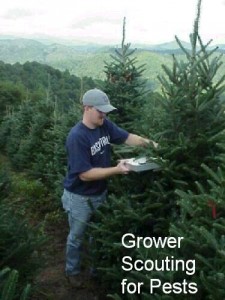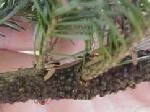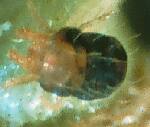Post-Harvest Pests on Christmas Trees
go.ncsu.edu/readext?293549
en Español / em Português
El inglés es el idioma de control de esta página. En la medida en que haya algún conflicto entre la traducción al inglés y la traducción, el inglés prevalece.
Al hacer clic en el enlace de traducción se activa un servicio de traducción gratuito para convertir la página al español. Al igual que con cualquier traducción por Internet, la conversión no es sensible al contexto y puede que no traduzca el texto en su significado original. NC State Extension no garantiza la exactitud del texto traducido. Por favor, tenga en cuenta que algunas aplicaciones y/o servicios pueden no funcionar como se espera cuando se traducen.
Português
Inglês é o idioma de controle desta página. Na medida que haja algum conflito entre o texto original em Inglês e a tradução, o Inglês prevalece.
Ao clicar no link de tradução, um serviço gratuito de tradução será ativado para converter a página para o Português. Como em qualquer tradução pela internet, a conversão não é sensivel ao contexto e pode não ocorrer a tradução para o significado orginal. O serviço de Extensão da Carolina do Norte (NC State Extension) não garante a exatidão do texto traduzido. Por favor, observe que algumas funções ou serviços podem não funcionar como esperado após a tradução.
English
English is the controlling language of this page. To the extent there is any conflict between the English text and the translation, English controls.
Clicking on the translation link activates a free translation service to convert the page to Spanish. As with any Internet translation, the conversion is not context-sensitive and may not translate the text to its original meaning. NC State Extension does not guarantee the accuracy of the translated text. Please note that some applications and/or services may not function as expected when translated.
Collapse ▲Christmas trees in North Carolina are grown in a near-natural setting. Most tree patches are adjacent to woods. Native broad leaf plants and grasses serve as ground covers around trees. There is an abundance of wildlife, such as deer, turkey and songbirds. There is also an abundance of insect activity as butterflies, pollinators and natural predators like lady beetles and praying mantids find a place to live and thrive.
Do’s and Don’ts:
|
| Do: Shake your tree before setting it up in the home. Christmas trees can have anything from pollen to dust to leaves and dead needles. Shaking the tree will remove a lot of debris. Consider washing the tree with water from a garden house and letting it dry before bringing your tree inside. If post-harvest pests are present, you’ll see them falling out. |
| Don’t: Mash Cinara aphids or other pests on carpets or furnishings. They may leave a purple or red stain. |
| Do: Vacuum pests up using an attachment without a beater bar. |
| Don’t: Worry about the ornaments. The insects won’t stay on them until next year. |
| Do: Treat with an insecticide if necessary. The least toxic insecticide is insecticidal soap. This is an organic product. It can sometimes be found premixed in a spray bottle in home improvement stores. Another choice would be using aerosol home insecticides. Set them off near the infected tree, but unplug the lights first as the aerosol containers are flammable. |
| Do: Remove the tree from your house if the infestation is large. |
| Do: Return the tree for another one if treatments fail. |
| Don’t: Give up on a real tree. The odds are against your ever having this problem again. |
Unwanted Hitchhikers
Unfortunately, your real Christmas tree may have an unwanted hitchhiker. There are several kinds of insects that spend the winter in conifers such as Fraser fir. If you are an insect, a Christmas tree provides a well-protected place to live through the cold and snow of winter months. When you bring the tree into your home, they think spring has come and become active again, even reproducing in the home. A similar situation occurs when you leave houseplants outside on the patio in the summer, then bring them back inside. They may harbor spiders, sow bugs, earlyworms, or some other critter that has found a safe place to live. In Christmas trees, pests such as Cinara aphids, spider mites, and praying mantid egg cases may be found. Fortunately, with Christmas trees, these unwanted hitchhikers do not bite or cause disease. Like ants at a picnic, they are just a nuisance. In many ways these hitchhikers are a symptom of a fresh tree recently harvested.
Rarely Occur
Most years, these pests are rare. Perhaps one tree in 100,000 has any one of these pests on it. Chances are you can get a real tree every year for the rest of your life and never be troubled with them again.
A Worse Problem in Warm Falls
These insects are active later in the fall when there are unseasonably warm temperatures. Therefore we experience worse problems in years with a warm, dry fall such as 1994, 1999, 2004, and 2006.
Not the Grower’s Fault
 Should the growers have treated for these pests? Unfortunately, they didn’t even know they were there or they would have. Sometimes it’s like trying to find a needle in a haystack. When enough trees are infested with pests, they can be found through scouting and treated. But sometimes only one tree in more than an acre of trees has one of these post-harvest pests on it. No one notices they are in the tree until they are brought into the home. Growers try to be good stewards of the land and water. Most growers strive to use pesticides only when they are needed to preserve tree quality and when they would effectively control the pest.
Should the growers have treated for these pests? Unfortunately, they didn’t even know they were there or they would have. Sometimes it’s like trying to find a needle in a haystack. When enough trees are infested with pests, they can be found through scouting and treated. But sometimes only one tree in more than an acre of trees has one of these post-harvest pests on it. No one notices they are in the tree until they are brought into the home. Growers try to be good stewards of the land and water. Most growers strive to use pesticides only when they are needed to preserve tree quality and when they would effectively control the pest.
Rogues’ Gallery of Post-Harvest Pests
For More information
- Printer Friendly Version of this document
- Post-Harvest Pests on Christmas Trees: Control on the Retail Lot / Printer Friendly Version
- Cinara Aphids on Christmas Trees in North Carolina
- “Bugs” and the Real Christmas Tree (Pennsylvania Dept. of Agriculture)
Prepared by Jill Sidebottom and Jeff Owen Area Christmas Tree Specialists NCSU College of Natural Resources N.C. Cooperative Extension Service





